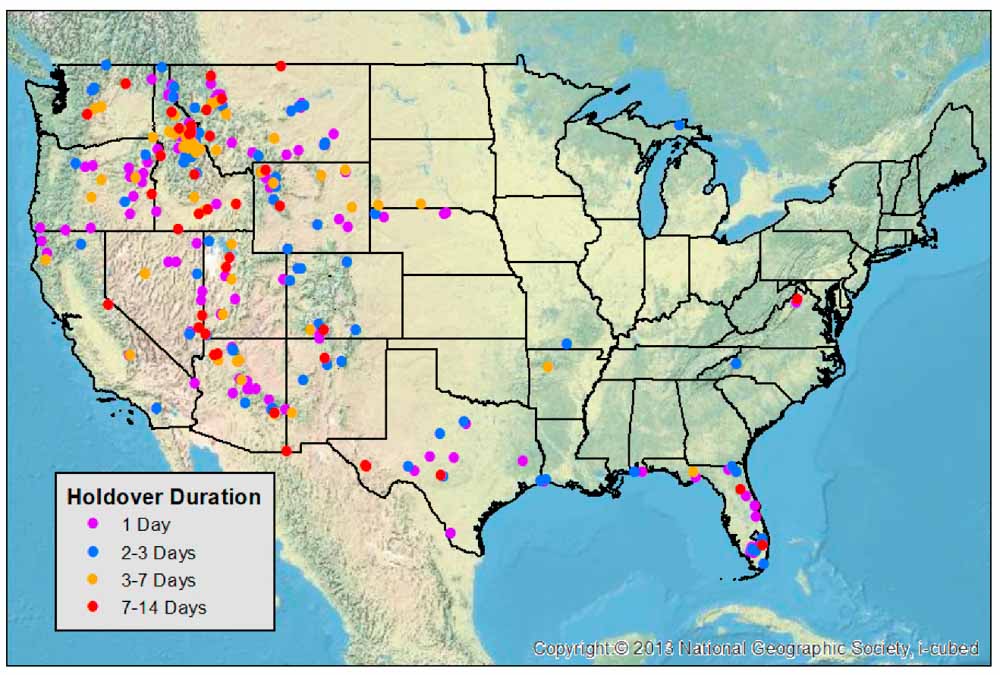
Researchers have found that about a quarter of the fires caused by lightning that grow to more than 4 km² (988 acres) are reported more than a week after they are ignited.
A paper published in the Fire Open Access Journal describes how the National Lightning Detection Network (NLDN) and U.S. Forest Service fire data were used to determine the correlation between lightning strikes and the reported location of lightning-caused wildfires.
The NLDN, which has been used operationally for several decades, consists of 113 sensors across the continental United States and has a reported flash detection efficiency of cloud to ground flashes between 90–95%, with spatial errors that are typically less than 500 meters for the flash data used in the study.
The researchers found, of lightning-caused fires that grew to more than 4 km² (988 acres):
50% reported the same day
71% reported within 3 days
73% reported within 5 days
77% reported within 7 days
Holdover fires that are not reported for days or weeks after the lightning occurs can be problematic for land managers. Shortly after a thunderstorm has left the area, fire detection efforts are often ramped up and may continue in that mode for a few days. Fires that smolder in duff or under snow and suddenly grow can be unexpected. Firefighting resources that may have been staged in anticipation of emerging fires could be released or assigned to active incidents, complicating efforts at quick initial attack with overwhelming force.
Authors of the paper: Christopher J. Schultz, Nicholas J. Nauslar, J. Brent Wachter, Christopher R. Hain, and Jordan R. Bell.

This report seems to makes a lot of assumptions and generalizations. For instance: “Therefore, some of these events may be human caused but because there were thunderstorms somewhere near the fire start location, they were reported as lightning-initiated. However, based on the experience of the operational fire community and the authors of this paper, misreporting is the least likely reason given the extensive methods used for fire investigation.”
Based on my experience and observation of investigation methods, I would say it is highly likely that fires are reported as lightning caused with little to no evidence to support such a claim. It seems odd that these authors are willing to assume that a fire report would misreport a start one day before it actually started, but those same firefighters are going to conduct an effective investigation to conclusively establish lightning as the cause.
There are a whole lot of social, cultural, environmental, and operational factors that contribute to a fire getting to 4km in size. Many of those same reasons contribute to the lack of detection and reporting. It seems they should take another swing while using some controls for those factors.
One last poke which is why I even read the report to begin with. Are there really fires holding over for 7-14 days in cheat and sage grass near Twin Falls, ID? Maybe the map isn’t so accurate, but there are a few head scratchers in there…
About 2 years ago, we had a very spectacular lightning caused fire.
My 15 acre backyard was Ground Zero for about 15 minutes.
I positioned a camera on an aluminum ladder and then realized, “oh, yes, aluminum is conductive … I should watch from indoors.”
Shortly after the lightning passed our area, it dropped 2 inches of rain in 45 minutes. Literally.
Even after all that, a neighbor had to call for a fire truck to extinguish a small fire in a pile of sticks near to their house. That very impressive rain-drop did not extinguish all the fire-starts.
Holdover fires are common in our Region anywhere from 3-10 days.We aerial patrol once the RH drops below 30% and notice most arround 17:00 each day.Most are spotted in the 0.1 – 2 acre range.Sheer numbers on a given day allow some to be detected at a larger size.Active regular patrols are the key to Ltg fires.
Detection of lightning caused fires, whether holdover (sleepers) or not, are routinely reported by fire lookouts in a timely manner. More timely than by aircraft since lookouts are available 24 hrs/day. As a Forest Service lookout on the San Juan NF I called in 29 smokes last year. None of these grew to more than ten acres in size before being suppressed. In addition to timely detection the fire lookout provides valuable, real-time weather observations and changes in fire behavior to ICs and firefighters.